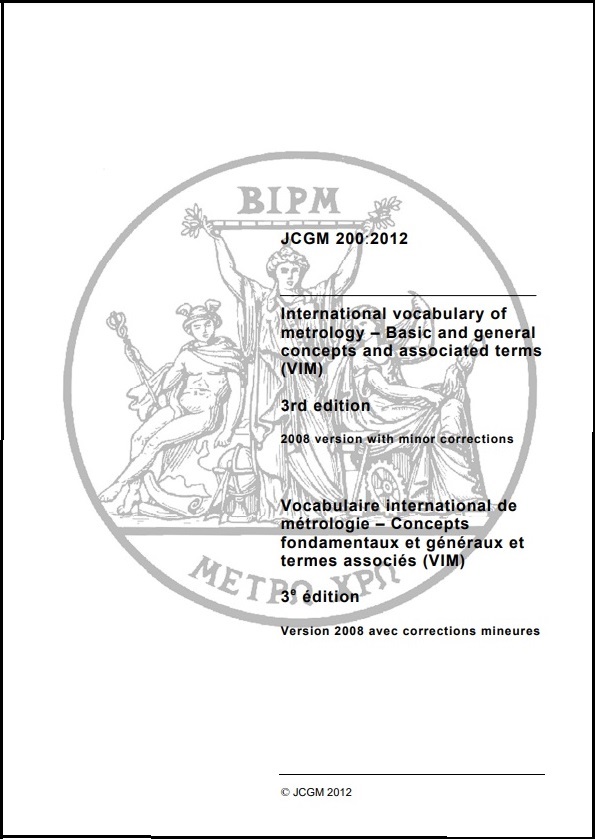International Vocabulary of Metrology (VIM) is a “System of Units”, not a “System of Measurement”. The VIM explains the terminology used in publications related to measurement, including the official SI brochure.
Background
Communication between people relies on an agreement as to what various words/gestures mean. The Oxford English Dictionary (OED) provides a reference point for words used in everyday English. Its model is to catalogue words that have become commonplace in the English language once they have been widely accepted. However, this does not prevent differences in meaning emerging on each side of the Atlantic Ocean. The motor industry is a prime example of how two different vocabularies have emerged despite the same technology.

Many specialised disciplines have produced dictionaries of jargon that has become commonplace in that particular discipline. Often the dictionaries concerned use definitions that originate in academia to forestall multiple concepts being attached to the same word or one concept having multiple names. In the case of metrology, eight international organisations including BIPM and ISO have joined forces to create an organisation called the Joint Committee for Guides in Metrology (JCGM). Their brief is to produce documents that ensure consistency in language across the work of all the member organisations. [Ref 1] To date two documents have appeared – International Vocabulary of Metrology (VIM) [Ref 2] and Guide to the Expression of Uncertainty in Measurement (GUM). The documents themselves are published by the constituent organisations using their own covers and are available free of charge on the Internet.
International Vocabulary of Metrology
The first of these two documents is of principal interest to MV readers as it defines the terminology used in the SI Brochure and elsewhere. Moreover, both VIM and GUM appears as bilingual documents with the aim of ensuring a one-to-one correspondence between the English and the French languages. Countries that use languages other than English or French are encouraged to translate these documents into their own languages. To date the author has identified translations in Spanish [Ref 3], Italian [Ref 4] and German [ref 5].
The fourth edition of VIM is currently undergoing review, so this article will discuss the third edition (published 2008, updated 2012). The document contains five chapters:
- Quantities and units
- Measurement
- Devices for measurement
- Properties of measuring devices
- Measurement standards (Etalons)
Readers of MV are probably most interested in Chapter 1 of the guide with Chapters 2 and 5 putting the contents of Chapter 1 into context.
The first section has formal descriptions of the terms used to describe a system of units starting with the description of a “quantity” which can either be continuous in nature such as “length”, “mass” etc or discrete in nature such as “Rockwell hardness”. It formally defines a hierarchy of concepts, many of which are dependent on concepts that have been previously defined. For example, the formal definition of the “International System of Units” (VIM definition 1.16) is:
“system of units, based on the International System of Quantities, their names and symbols, including a series of prefixes and their names and symbols, together with rules for their use, adopted by the General Conference on Weights and Measures (CGPM)”.
This definition is dependent on the definitions “system of units” (VIM definition 1.13) and “International System of Quantities” (VIM definition 1.6), both of which are defined within the document. [Note 3]
The way in which systems of units are defined is done in a way that is context neutral – the definitions hold equally well for the imperial system as they do for SI with the obvious exception that the imperial system does not comply with the definition of a “coherent system of units”.
The rest of the document is oriented towards making measurements and how one should express uncertainties associated with such operations. The concluding chapter provides a vocabulary for the creation of physical standards such as the UK national prototype metre and kilogram which are held by the NPL and copies of those standards that are held by trading standards officers. I will not describe those sections in detail –VIM can easily be downloaded from the internet.
“System of Measurement” or “System of Units”?
The document’s introduction has a paragraph on the use of the French words “mesure” and “mesurage” and in particular why the word “mesure” can be ambiguous unless it has a qualifier such as “unité de mesure”. One of the consequences of this is that the English equivalent of the expression “système de mesure” is “measuring system” (VIM definition 3.2) while VIM makes no mention of the English phrase “system of measurement”. [Note 1].
VIM describes the term “system of units” (VIM definition 1.13) [Notes 2 & 3] as being equivalent to the French “système d’unités”. The Spanish equivalent is “sistema de unidades” while the Italian and German translations likewise have equivalents of the word “units” rather than the word “measurements”. This suggests that the use of the expression “System of measurement” should be abandoned for of the expression “System of units” (which can be taken to be a shorthand for “system of units of measurement”).
SI is, of course, an abbreviation for “Système international d’unités” or, in English “International System of Units”.
Finally …
The author recommends that anybody who is writing about the metric system reads the International Vocabulary of Metrology, if only to ensure that they are aware of the correct use of vocabulary.
Notes
- “Measuring System” (VIM definition 3.2) is defined as “set of one or more measuring instruments and often other devices …”
- “System of Units” is defined “set of base units and derived units, together with their multiples and submultiples, defined in accordance with given rules, for a given system of quantities”.
- Items in bold are defined within VIM.
References
- https://en.wikipedia.org/wiki/Joint_Committee_for_Guides_in_Metrology
- https://www.bipm.org/documents/20126/2071204/JCGM_200_2012.pdf/f0e1ad45-d337-bbeb-53a6-15fe649d0ff1
- https://www.cem.es/sites/default/files/vim-cem-2012web.pdf
- https://www.eurachem.org/images/stories/Guides/pdf/TAM_2011_IT.pdf
- https://www.libristo.eu/en/book/internationales-worterbuch-der-metrologie-international-vocabulary-of-basic-and-general-terms-in-metrology_01480812

Excellent post! :-) from punditgi aka Ezra :-)
LikeLike